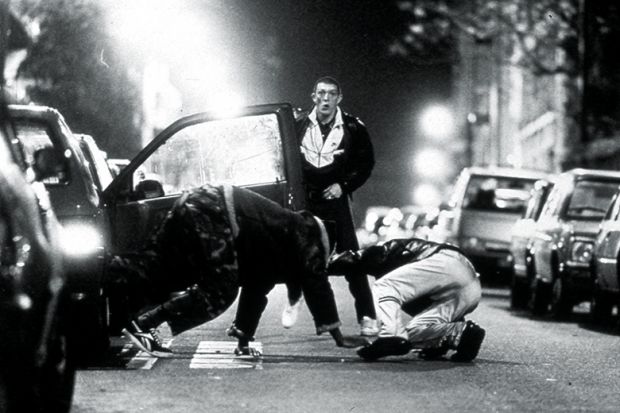In Mathieu Kassovitz’s acclaimed film La Haine (Hate, 1995), a group of young French men (played by Vincent Cassel, Saïd Taghmaoui and Hubert Koundé) travel from the predominantly working-class suburbs of Paris to explore the city not as inhabitants of its gentrified boulevards but as marginalised spectators, setting off car alarms and poking fun at gallery-goers. Kassovitz’s film is memorable, and present on most film degree courses, because it offers a deeply politicised and youth-oriented view of Paris from the perspective of an under-represented milieu of mixed-race and working-class Parisians in the peripheral zones of the city known as les banlieues.
The co-editor of Paris in the Cinema, Ginette Vincendeau, is well known for her work on La Haine and her incisive treatment of its representation of Paris as cinematic landscape and aesthetic creation (Kassovitz shot his entire film in black and white to reinforce its style and radical tone). Here, more than 10 years later, she and Alastair Phillips have invited other academics to reflect further on films such as La Haine (pictured) which have indelibly altered our conception of Paris.
Indeed, as they remind us, Paris is “the ‘official’ birthplace of the cinema”, with “the first public screening at the Grand Café, Boulevard des Capucines, on 28 December 1895”. Furthermore, the book’s introduction suggests, “Paris holds a special place within the development of studies of cinema and the city, as the location where, or about which, many of the seminal texts on urban modernity and post-modernity have been written, notably by Charles Baudelaire, Walter Benjamin, Guy Debord, Henri Lefebvre, Michel de Certeau, Anne Friedberg, Janet Wolff, Elizabeth Wilson and Marc Augé.”
The subtitle of Paris in the Cinema alludes to the notion of Baudelaire’s flâneur, in essence a privileged, modern and typically male consumer of the city, strolling and wandering freely while taking in the pleasures of the boulevards and arcades.
Yet the book looks beyond the flâneur, demonstrating how the city is newly presented to film viewers from the position of the other – the female, the French-Algerian, the hotel worker, housewives and waitresses. While the figure of the flâneur is a vividly evoked point of departure, the contributors go on to include rich and valuable reflections on a range of issues, such as Parisian amateur film-making, Charles Dickens’ debt to Paris and contemporary cinema’s representation of les banlieues.
In addition to the remarkable essays, this book includes Isabelle Vanderschelden’s brilliant interview with Jean-Pierre Jeunet (director of Amélie, 2001). Indeed, such an interview makes a fitting end to a book that opens with a figure synonymous with male subjectivity by evoking a waitress whose nuanced exploration of Paris marks her out as a flâneuse, a persona also perfectly encapsulated in the female singer described in Jennifer Wallace’s chapter on Agnès Varda’s Cléo de 5 à 7 (Cleo from 5 to 7, 1962).
Davina Quinlivan is a senior lecturer in critical and historical studies at Kingston School of Art, Kingston University. She is the author of Filming the Body in Crisis (2015) and The Place of Breath in Cinema (2012). She is working on a study of the British film director Joanna Hogg.
Paris in the Cinema: Beyond the Flâneur
Edited by Alastair Phillips and Ginette Vincendeau
British Film Institute, 286pp, £24.99
ISBN 9781844578177
Published 30 November 2017
